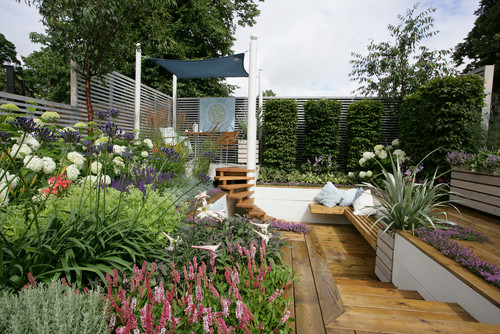Lawn care in West Chester, Ohio is a task many families are willing to undertake because of the countless benefits provided by lawns Aside from helping clean the air, a lawn also serves as a refuge where you can rest and relax after a hard day’s work.
Of course, when children come along, yards become less an area for relaxation and more of a playground for the little ones. If this is the case, you must ensure that every corner and slope in your landscape are child-safe.

Surprising as it may be, many people spend so much time ensuring that their kids are safe indoors, only to forget doing the same for their outdoor space. To help you avoid this mistake, here are six tips for a child-friendly yard from landscaping experts in Mason, Ohio:
1. Avoid potentially dangerous plants
Gardening is an excellent pastime, but when kids are involved, you must carefully pick the plants you add to your property. Though they may not necessarily be poisonous, certain plants pose dangers to your child’s wellbeing.
Children, especially younger ones, are naturally inquisitive. While it is good to entertain this curiosity and let them learn about the things around them, you must still take precautions to prevent any untoward incidents.
That said, below are some plants you should be mindful of as they could potentially cause harm to your little one:
Lily of the Valley
The beautiful perennial lily of the valley offers a unique element to shaded gardens. But since it is a poisonousplant, you have to be careful where you place it. If you cannot remove it from your landscape, you should at least keep it out of children’s reach.
Prickly Pear Cactus
While it’s okay to have cacti in your backyard when you have older kids, the situation may not be the same with younger children. Certain types of cacti, like prickly pear cactus, have needles and thorns that can be quite painful when touched.
Roses
Sure, these look great in your yard, especially when they’re in bloom. But when it comes to protecting the little ones, you must make the necessary sacrifices.
Keep thorny rose bushes away from youngsters who may be attracted to the vibrant blooms, only to get pricked by the thorns that hide beneath.
It’s best to wait until the kids are old enough to plant these gorgeous flowers around your property.
2. Prevent accidents with non-skid surfaces
While it’s impossible to prevent every accident from occurring, you can limit injuries with non-slip and non-skid surfaces like pavers.
From the patio and walkways to the deck area, ensure that places where children may trip or slip in have this type of surface instead of a hardscape. It is also recommended for areas around the swimming pool and other surfaces that are likely to get wet.
Also, remember that scraped knees aren’t your only concern when it comes to water features. When you have pools, Jacuzzis, fountains, and artificial ponds, you must prevent children from falling into the water. This is where the next item becomes useful.
3. Keep pools and other water features fenced
Pools and other water features should be fenced, especially for households with children aged two years and below. Toddlers have a tendency to be attracted to water, especially if they previously had their first swim there recently.
To prevent accidents whenever your eyes are turned away, keep these water features fenced. Of course, this isn’t the only option you have when it comes to unsupervised children; it’s just that fences are the most effective solutions in most situations.
Sure, you can install door alarms that let you know when a child passes through the house exit points. However, they don’t prevent accidental drowning in case the little one is already outside with an adult who’s busy gardening or preoccupied with something else.
More importantly, putting a fence around water features allows your child to safely enjoy other areas in your yard that are okay for them to use, such as the playards, patio, and lawn.
4. Stick to natural elements
Many parents think that making their landscape child-friendly means buying a ton of plastic playground implements. But this shouldn’t be the case.
The truth is that children learn about their environment better if they’re surrounded by natural features, like tree stumps that double as seating areas and an obstacle course. You can also postpone clearing branches, leaves, and trimmed grass away and let your kids use them as materials for their very own outdoor science project.
So, skimp on the plastic ladders and slides, and let your little one enjoy nature’s very own playground.
5. Excite their senses with a sensory garden
These days, children are so absorbed with their gadgets they cannot appreciate the wonders Mother Nature has to offer. Make sure your kids learn as much as possible from their environment by creating a sensory garden to excite all five of their senses.
To stimulate the sense of sight, plant brightly colored flowers, like nasturtiums, sunflowers, and marigolds, or add Swiss chard for its multicolored stems.
When it’s quiet, let your child’s sense of hearing get the most out of rattling seed heads and rustling grasses as he touches a variety of textures – from the smooth flower petals to the downy leaves of sage.
Finally, let your child enjoy nature’s scents by planting chocolate cosmos and curry plant or choosing peppermint and creeping thyme as groundcover (instead of traditional turf grass), which can also make flavorful additions to your evening dish and drinks.
6. Go for multipurpose furniture
Multipurpose furniture helps reduce costs while allowing you to use your landscaped space for several purposes.
For example, if your little one wants to have a swing, you can offer them a wooden rocking seat instead. This is a great alternative for smaller spaces that cannot accommodate a bigger structure.
Similarly, you may also tie a fabric hammock between two posts or a portable stand to have instant swinging furniture that can double as a place for relaxation.
Create space for your growing family
Creating a child-friendly space means more than just ensuring their safety – it’s also ensuring that they get the best experiences. Try to apply the tips in this article when landscaping, and you’ll surely achieve a landscaped space perfect for your growing family.




